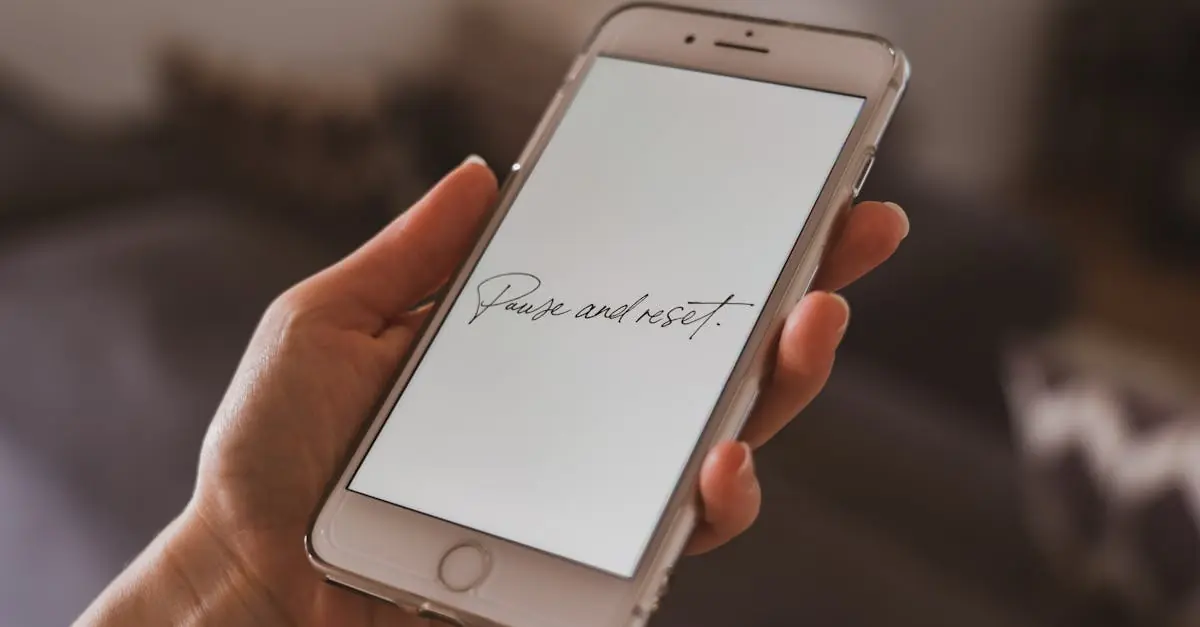Table of Contents
ToggleIn the world of smartphones, the iPhone 13 reigns supreme, but even the best can hit a snag. Whether it’s frozen apps or a stubborn screen, sometimes a little digital kick is all it takes to get things back on track. Enter the force reset—a simple yet powerful trick that can save the day and restore your sanity.
Overview of iPhone 13
iPhone 13 ranks as one of the most advanced smartphones available. Users enjoy its A15 Bionic chip, which enhances performance and efficiency. The device features a dual-camera system, incorporating improved low-light capabilities for photography enthusiasts. Battery life stands out, offering up to 19 hours of video playback. This feature appeals to those who use their phones extensively throughout the day.
In addition to hardware improvements, iPhone 13 also comes equipped with iOS 15, introducing new functionalities and user-friendly enhancements. The OLED display provides vibrant colors and incredible contrast, making media consumption more enjoyable. Storage options range from 128GB to 512GB, offering flexibility based on user needs.
Despite being a top-tier device, the iPhone 13 can experience software glitches or unresponsive screens over time. Situations like these are not uncommon among smartphone users. A force reset serves as an effective solution to address these issues quickly. Knowing how to perform this reset can save time and ensure the device returns to normal functionality.
Overall, the iPhone 13 remains a superior choice among smartphones, thanks to its powerful specifications and user-focused design. Users can rely on its advanced capabilities, but being prepared for occasional troubleshooting enhances the overall experience.
Reasons to Force Reset Your iPhone 13
Force resetting your iPhone 13 proves useful in various situations. Common issues like unresponsive screens or persistent software glitches often prompt users to take this action.
Unresponsive Device
An unresponsive device can create frustration, halting daily tasks. Force resetting promptly reinstates normal functionality. Pressing the volume up button, followed by the volume down button, then holding the side button until the Apple logo appears effectively rejuvenates the device. This process interrupts any temporary freezes, allowing the phone to restart and operate smoothly.
Troubleshooting Software Issues
Software issues tend to arise on occasion, even with advanced systems like iOS 15. Frequent app crashes or sluggish performance may indicate underlying problems. Performing a force reset clears temporary data that can cause excessive resource consumption. This step often resolves issues without requiring extensive troubleshooting. Just remember that it can also help restore normal performance levels after a software update or installation of new apps.
Step-by-Step Guide on How to Force Reset iPhone 13
Force resetting the iPhone 13 can resolve various issues quickly. Here are two methods to accomplish this task effectively.
Method 1: Using Physical Buttons
To reset using physical buttons, begin by pressing and quickly releasing the Volume Up button. Next, press and quickly release the Volume Down button. Finally, press and hold the Side button until the Apple logo appears on the screen. This process interrupts any unresponsive behavior in seconds, making it a straightforward solution for frozen apps or screens. Both the Volume and Side buttons play crucial roles in this method.
Method 2: Using Settings (If Accessible)
If the device remains responsive, access the Settings app. Navigate to General, then scroll down to the Shut Down option. Swipe the slider to power off the device completely. Turning it back on can refresh the system and resolve minor software issues. This alternative method suits users who prefer not to use physical buttons. Each approach effectively addresses common problems users may experience with their iPhone 13.
Important Considerations
When performing a force reset on the iPhone 13, users should consider potential data loss and the importance of backing up their information beforehand.
Data Loss Risks
Data loss can occur during a force reset, especially if it interrupts ongoing processes or updates. While a reset primarily targets temporary issues, any unsaved data can vanish in the process. Users should remain cautious, understanding that important files and settings may get compromised. Frequent resets without proper saving procedures might lead to software corruption, making it essential to assess the risks involved.
Backup Recommendations
Backing up the iPhone 13 is critical before initiating a force reset. Effective methods include using iCloud or connecting the device to a computer running iTunes or Finder for a complete backup. Regular backups safeguard against unpredictable data loss, ensuring all essential files like photos, contacts, and documents remain intact. Setting the device to back up automatically weekly reduces risks during troubleshooting, allowing users to proceed confidently with resetting their devices.
For users of the iPhone 13 encountering issues like frozen apps or unresponsive screens a force reset serves as a quick and effective solution. This simple process can restore functionality and alleviate software-related problems without extensive troubleshooting.
It’s crucial to remember the importance of backing up data before performing a force reset to avoid potential data loss. Regular backups ensure that essential files remain safe and accessible. By being prepared for occasional troubleshooting users can maintain the impressive performance and capabilities of their iPhone 13 while enjoying a seamless experience.




